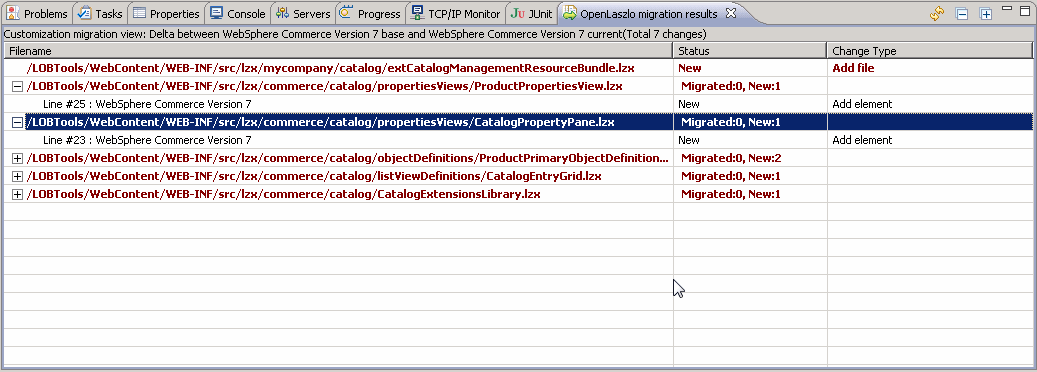
Identifying customizations on Management Center Version 7 Feature Pack x
If you have previously installed and enabled the Management Center feature provided in a Version 7 Feature pack, review this information. Customizations that you made to the Management Center in a lower WebSphere Commerce Version 7 Feature pack installation (Version 7 Feature Pack x, for example, Version 7 or Version Feature Pack 1) can be identified after you install a higher WebSphere Commerce version 7 Feature pack (Version 7 Feature Pack y, for example, Version 7 Feature Pack 2).
Before you begin
The Eclipse compare editor does not
display line numbers by default. The lines numbers assist you in determining
what location within the file, has changed. To ensure that line numbers
are shown in the compare editor view, complete the following steps:
- Start WebSphere Commerce Developer
- Click Window > Preferences.
- Expand Workbench and select General> Compare/Patch.
- Select Show additional compare information in the status line.
- Expand Workbench and select .
- Select Show line numbers.
Notes:
 In WebSphere Commerce Version 7, the OpenLaszlo
files are contained in both restricted and non-restricted directories.
Files in restricted directories are considered IBM assets and files
in non-restricted directories are custom assets. When enabling the
Version 7 Feature Pack 1 or Feature Pack 2 Management Center feature,
the files in the restricted directories are deleted from your workspace
and the files in non-restricted directories are overridden by the
corresponding files in Feature Pack 1 or Feature Pack 2.
In WebSphere Commerce Version 7, the OpenLaszlo
files are contained in both restricted and non-restricted directories.
Files in restricted directories are considered IBM assets and files
in non-restricted directories are custom assets. When enabling the
Version 7 Feature Pack 1 or Feature Pack 2 Management Center feature,
the files in the restricted directories are deleted from your workspace
and the files in non-restricted directories are overridden by the
corresponding files in Feature Pack 1 or Feature Pack 2. Between Version 7 and Version 7 Feature
Pack y, some elements have been moved to a different
parent or a different file. For each moved element the comparison
tool reports two entries; add element and delete element. The add
element is the new location of the element and the delete element
is the original location of the element.
Between Version 7 and Version 7 Feature
Pack y, some elements have been moved to a different
parent or a different file. For each moved element the comparison
tool reports two entries; add element and delete element. The add
element is the new location of the element and the delete element
is the original location of the element.
About this task
Installing WebSphere Commerce Developer Version 7 Feature Pack y (which is a higher Version 7 Feature Pack, for example FEP2) provides a new version of Management Center which includes a compare editor.
You can use the compare editor in these situations:
- After installing the Websphere Commerce Version 7 Feature Pack
Y, you can compare:
- Management Center changes between WebSphere Commerce Management Center Version 7 Feature Pack x (which is a lower Version 7 Feature Pack, for example FEP1) with any customizations you made in Management Center Version 7 Feature Pack x.
- After you enable the Management Center feature from the higher
Version 7 Feature Pack, you can compare:
- Management Center changes between Version 7 Feature Pack x base with any customizations you made in Version 7 Feature Pack x base.
- Management Center changes between Version 7 Feature Pack y base with any customizations you made in Version 7 Feature Pack y base.



 Right click
Right click  Right click
Right click 